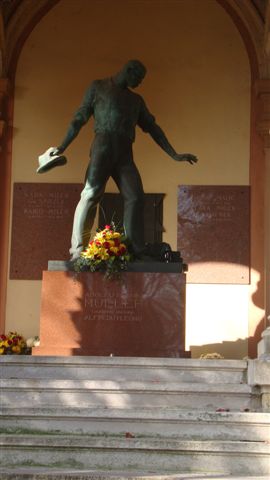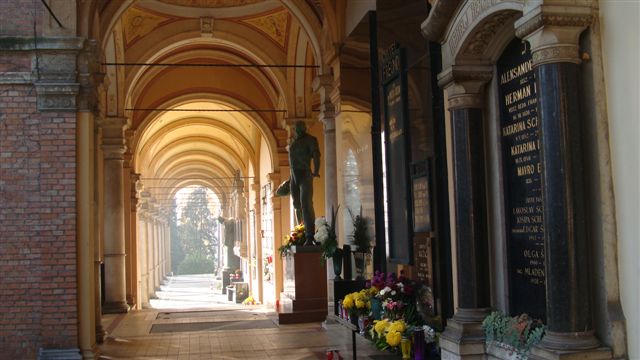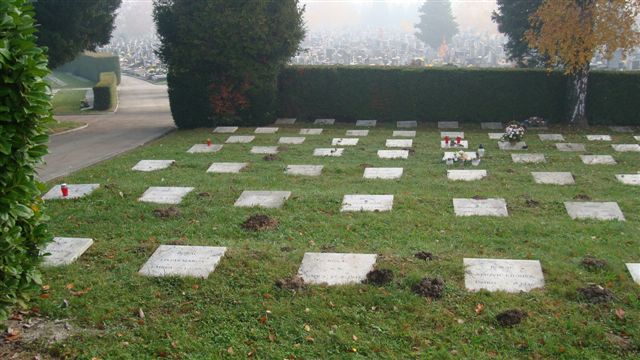Alternate names: Zagreb [Serb], Zágráb [Hung], Zagabria [Lat], Agram [Ger]. 45°48' N, 16°00' E, capitol of Croatia. 1890 Jewish population: 1,924. References:
- Encyclopedia of Jewish Life (2001), pp. 1482-1483: "Zagreb".
- Pinkas HaKehilot, Yugoslavia (1988), p. 127: "Zagreb"
- Renewed Survival: Jewish Community Life in Croatia.
- Jewish Guide to Croatia [July 2014]
City of Zagreb
Deputy Mayor: Darinko Kosor
Deputy Mayor: Mladen Vilfan
Jewish Communtiy Zagreb, Palmoticeva 16, 10000 Zagreb, el : 4922692. fax:4922694. e-mail : This email address is being protected from spambots. You need JavaScript enabled to view it.. Mikvah [February 2009]
Neo-Nazi Anti-Semitic attacks [February 2009]
town image {February 2009]
"The Jewish Community was established in 1806 with 75 members, but in 1941, Zagreb counted 11,000 Jews plus 1000 Jewish refugees who fleed East European countries. In Spring 1941, Ustashas, the extreme national movement and Nazi collaborators, came into power . After introducing racial laws, they organized mass murders of Jews either in concentration camps in Croatia or sent by Gestapo to death camps. 8,000 of Zagreb's Jews perished. About 1.000 Jews joined the partisans. Several hundred escaped the Ustashas to survive. In 1945, of the 2,500 Jewish survivors, half made aliyah in 1948 and 1949. By 1950, 1250 Jews remained to renew Jewish life in Zagreb. From 1945 to 1990, the Jewish umbrella organization was the Federation of Jewish Communites of Yugoslavia in Belgrade." Website [January 2009]
Jews probably settled in Zagreb around 1355. Today's population is about 1,500 of the country's 2000 or 2500 Jews. Expelled about 1450, they were not permitted to establish a permanent community again until the end of the 18th century. The original Zagreb Jewish religious community (about 75 members) was formally established in 1806. By 1940, nearly 12,000 Jews lived in this highly assimilated and most prosperous community in Yugoslavia. Most of its many businessmen, professionals, and intellectuals were killed in the Holocaust. The Jewish Community located at Palmoticeva 16 and built in 1857 has community offices, a synagogue, a kindergarten, an art gallery, club premises/function room, a Holocaust research and documentation center, and the Lavoslav Sik Library (the largest Jewish library in the Balkans. [February 2009]
"Synagogue on Praska St. built in 1867 by Franjo Klein was destroyed in 1941. Older synagogues in use until 1867. A small Winter Synagogue was opened in 1937 in the building of the Chief Rabbinate in Petrinjska St.. Sephardic and the Orthodox communities had separate synagogues." [Land Registry: Folder No: 15347 Plot No.: 2990] Jewish Community was established in 1806 and still exists. A separate Orthodox community existed 1925-41 and the Sephardic one from 1927-41. Jewish Population: 1925/26-12,000; 1931- 9,200; 1937/38-9,770; 1941- 13,000; 1947-2214; 1994-1,600. Jewish Community of Zagreb maintains register of all Jewish burial in Zagreb since 1862. It also keeps the original statutes and list of members of Chevra Kadisha (Burial Society) from 1853/54 in its archives. Contains statutes of HK and Bikur Holim Society, list of members, etc." See: Gruber, Ruth Ellen. Jewish Heritage Travel: A Guide to East-Central Europe. New York: John Wiley & Sons, Inc, 1992. (pages 239-240) Both the Jewish community building and the Jewish cemetery were hit by terrorist bombs in the 990s.
- First Jewish cemetery: by the St. Rok Church, opened in 1811 and used until 1877.
- Second Jewish Cemetery: The second Jewish cemetery was near the St. Peter Church opened in 1858 and used until 1878. Some monuments from both cemeteries were moved to the new one in 1878. There is a monument to Jewish Victims of World War II. Source: Srdjan Matic, MD, 40 West 95th Street, Apt. 1-B, New York, NY 10025. (212) 222-7783.
- Mirogoj Cemetery: Zagreb's central Mirogoj cemetery established in 1876 replaced several smaller, older cemeteries and was the city's first central cemetery serving all religions: Catholics, Muslims, Jews, and others. The Jewish section, established in 1878, replaced the two earlier Jewish cemeteries. Jewish Section is at Mirogojska cesta. Established in 1878 and still exists with a Ceremonial Hall. The original size was 13 fields (10 Ashkenazi, Neolog, 2 Sephardic, 1 Orthodox) with about 4-5000 monuments, now reduced to about 1,500 monuments. Property belongs to City of Zagreb. This was the city's first central cemetery serving all religions, where Catholics, Muslims, Jews, and other were buried. The Jewish section, established in 1878, replaced two earlier Jewish cemeteries one opened in 1811 and used for burials until 1877, and one opened in 1858, and used for burials until 1878. Some of the monuments from these cemeteries were moved to Mirogoj. A Holocuast monument to Jewish victims of World War II exists. The Jewish section at Mirogoj [official web site] originally had 13 separate sections (10 for Ashkenazi Neolog, two for Sephardic, and one for Orthodox with prominent Zagreb Jews buried in family tombs in one of the cemetery's arcades. The cemetery had 4,000 to 5,000 monuments, but now only about 1,500. Jewish graves replaced with graves of non-Jews resulted because local law permits graves not maintained after a generation to be sold to others as burial plots. In 1961 about 1,000 Jewish graves were exhumed and moved into a mass grave in the Jewish section of the main Zagreb cemetery after which the city sold the plots. Some old tombstones are replaced by a new monuments of the next burial, but the name of a newly buried person has been added to some existing tombstones instead. A Holocaust memorial by sculptor Antun Augustincic is a statute of Moses. A terrorist bomb was detonated in this Jewish section 1991 but damage was soon repaired. [January 2009]
- Architect Herman Bollè, who died in 1926, designed the cemetery as a park and an open-air art gallery in additional to a place of burial. Monumental arcades, pavilions, and domes, rich vegetation and sculptures exist although his plan to encircle the entire cemetery with impressive arcades never materialized due to due to lack of funds. [February 2009]
Photos courtesy Dr. Daniel Aldo Teveles




